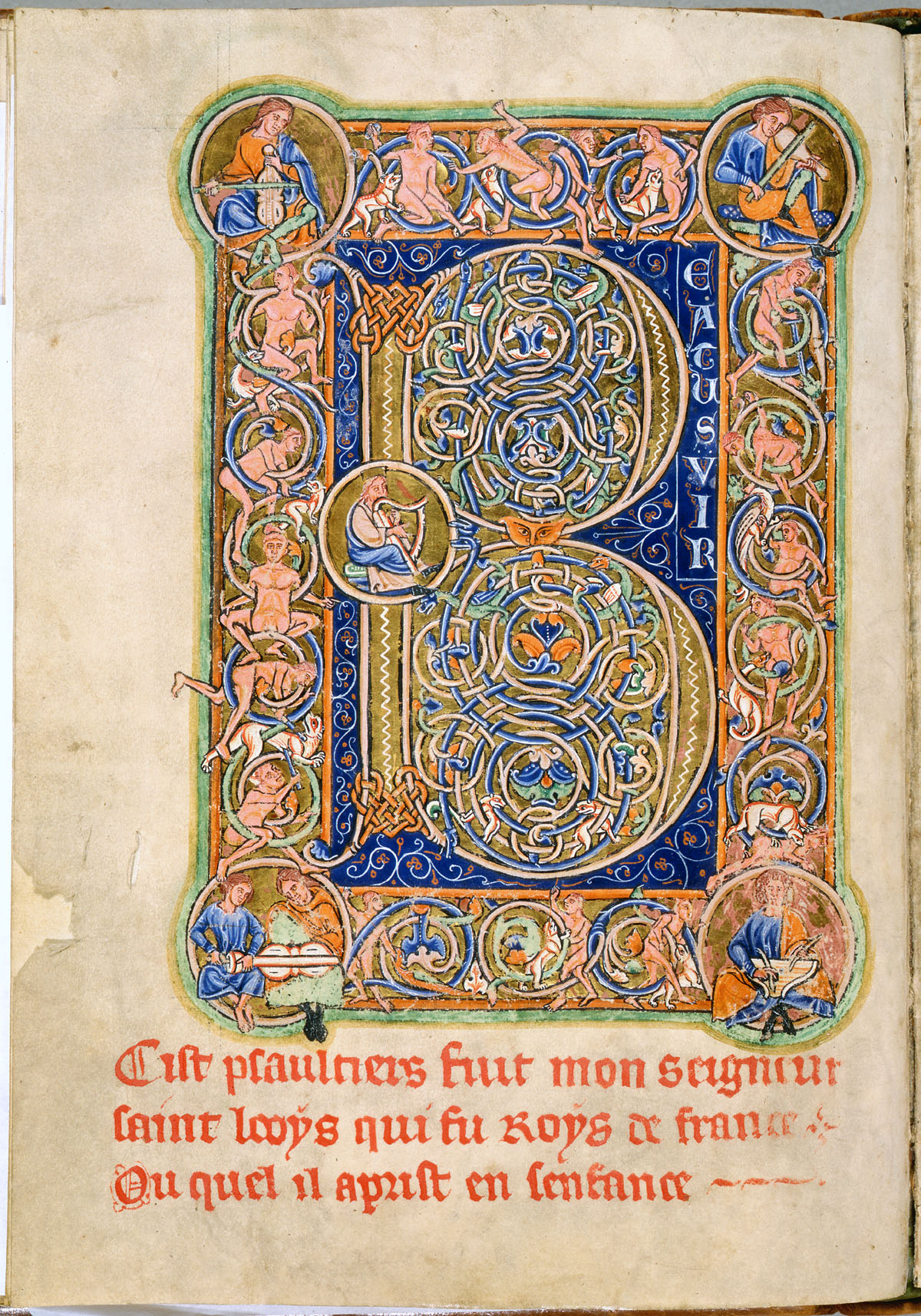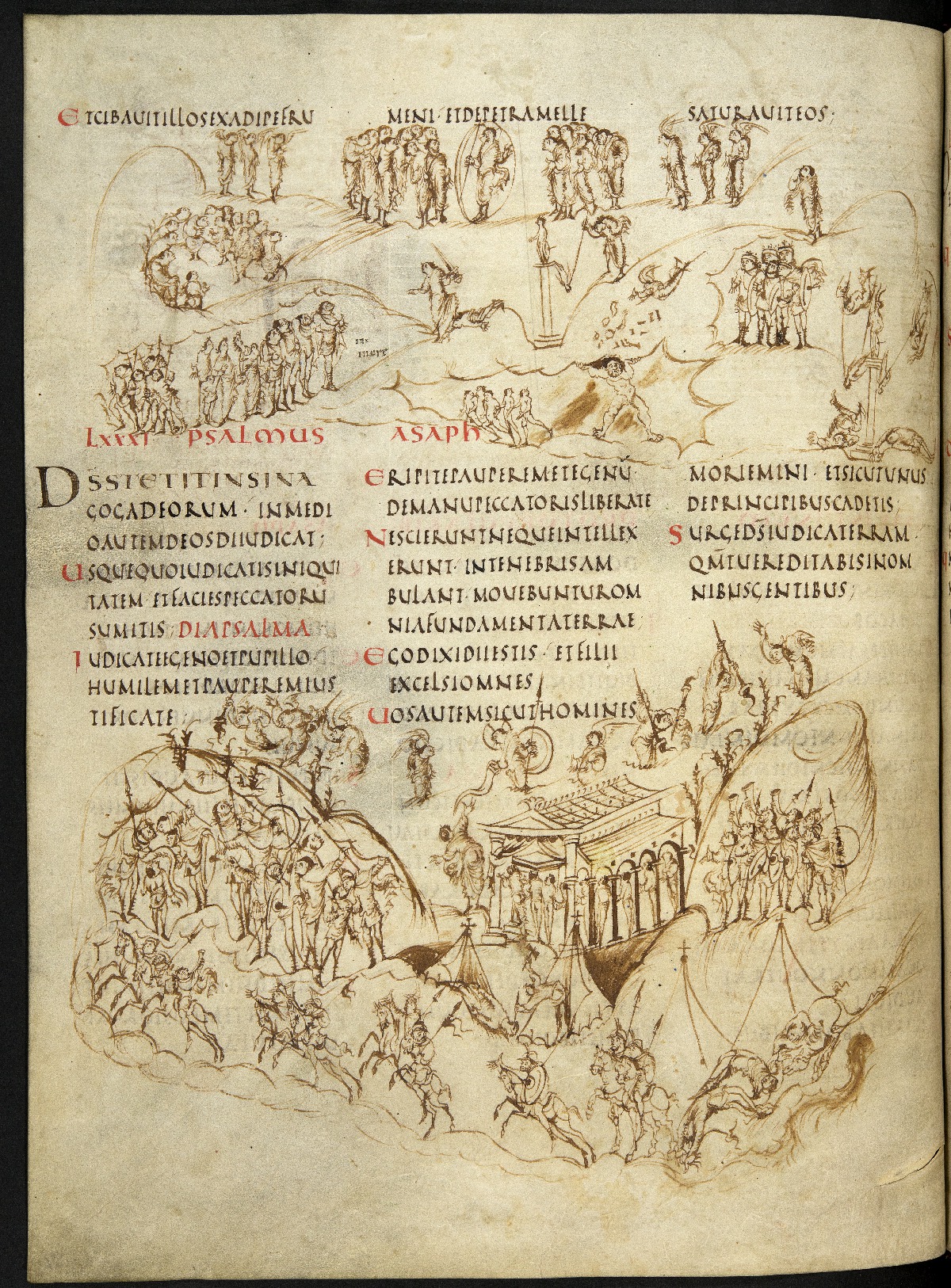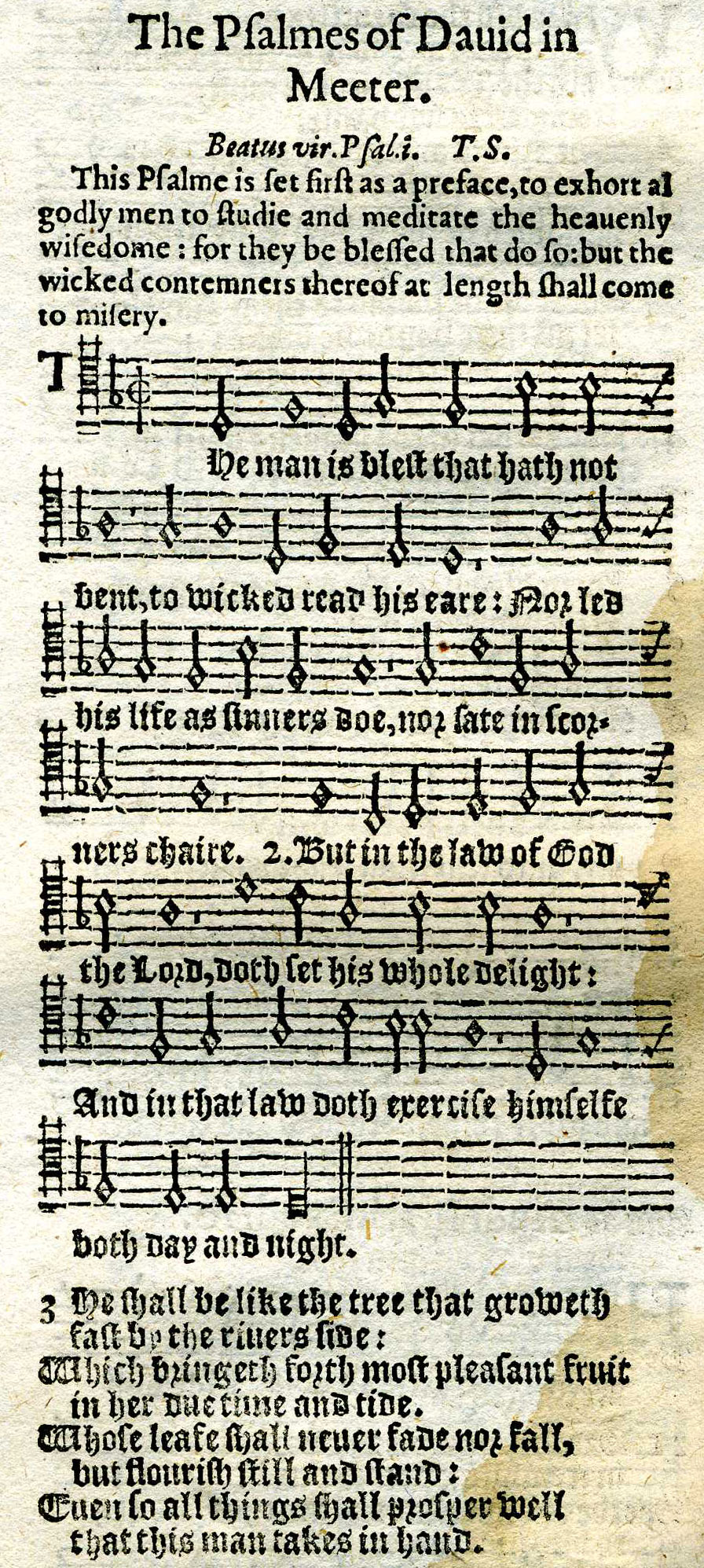|
Psalters
A psalter is a volume containing the Book of Psalms, often with other devotional material bound in as well, such as a liturgical calendar and litany of the Saints. Until the emergence of the book of hours in the Late Middle Ages, psalters were the books most widely owned by wealthy lay persons. They were commonly used for learning to read. Many psalters were richly illuminated, and they include some of the most spectacular surviving examples of medieval book art. The English term (Old English , ) derives from Church Latin. The source term is , which is simply the name of the Book of Psalms (in secular Latin, it is the term for a stringed instrument, from ''psalterion''). The Book of Psalms contains the bulk of the Divine Office of the Roman Catholic Church. The other books associated with it were the Lectionary, the Antiphonary, and Responsoriale, and the Hymnary. In Late Modern English, ''psalter'' has mostly ceased to refer to the Book of Psalms (as the text of a book o ... [...More Info...] [...Related Items...] OR: [Wikipedia] [Google] [Baidu] |
Latin Psalters
There exist a number of translations of the Book of Psalms into the Latin language. They are a resource used in the Liturgy of the Hours and other forms of the canonical hours in the Latin liturgical rites of the Catholic Church. These translations are typically placed in a separate volume or a section of the breviary called the psalter, in which the psalms are arranged to be prayed at the canonical hours of the day. In the Middle Ages, psalters were often lavish illuminated manuscripts, and in the Romanesque and early Gothic period were the type of book most often chosen to be richly illuminated. Versions The Latin Church has a number of more or less different full translations of the psalms into Latin. Three of these translations, the ''Romana'', ''Gallicana'', and ''juxta Hebraicum'', have been traditionally ascribed to Jerome, the author of most of the Latin Vulgate; however, the ''Romana'' was not produced by Jerome. Two other translations, the Pian and ''Nova Vulgata'' ... [...More Info...] [...Related Items...] OR: [Wikipedia] [Google] [Baidu] |
Utrecht Psalter
The Utrecht Psalter (Utrecht, Universiteitsbibliotheek, MS Bibl. Rhenotraiectinae I Nr 32.) is a ninth-century illuminated manuscript, illuminated psalter which is a key masterpiece of Carolingian art; it is probably the most valuable manuscript in the Netherlands. It is famous for its 166 lively pen illustrations, with one accompanying each psalm and the other texts in the manuscript (Chazelle, 1055). The precise purpose of these illustrations, and the extent of their dependence on earlier models, have been matters of art-historical controversy. The psalter spent the period between about 1000 to 1640 in England, where it had a profound influence on Anglo-Saxon art, giving rise to what is known as the "Utrecht style". It was copied at least three times in the Middle Ages. A complete facsimile edition of the psalter was made in 1875 (Lowe, 237), and another in 1984 (Graz). The other texts in the book include some Canticle, canticles and hymns used in the Liturgy of the Hours, offi ... [...More Info...] [...Related Items...] OR: [Wikipedia] [Google] [Baidu] |
Beatus Initial
''Beatus vir'' (; "Blessed is the man...") are the first words in the Latin Vulgate Bible of both Psalm 1 and Psalm 112 (in the general modern numbering; it is Psalm 111 in the Greek Septuagint and the Vulgate). In each case, the words are used to refer to frequent and significant uses of these psalms in art, although the two psalms are prominent in different fields, art in the case of Psalm 1 and music in the case of Psalm 112. In psalter manuscripts, the initial letter B of Beatus is often rendered prominently as a Beatus initial. Altogether the phrase occurs 14 times in the Vulgate text, eight times in the Book of Psalms, and four times in the rest of the Old Testament, but no uses in the New Testament. Psalm 1 in art Psalm 1 naturally begins the text of the Book of Psalms. In illuminated manuscript psalters this start was traditionally marked by a large Beatus initial for the B of Beatus, and the two opening words are often much larger than the rest of the text. Between t ... [...More Info...] [...Related Items...] OR: [Wikipedia] [Google] [Baidu] |
Antiphonary
An antiphonary or antiphonal is one of the liturgical books intended for use (i.e. in the liturgical choir), and originally characterized, as its name implies, by the assignment to it principally of the antiphons used in various parts of the Latin liturgical rites. Medieval antiphonaries varied with regional liturgical tradition. In 1570, following the Council of Trent, the Roman Rite antiphonary was declared universal. The Roman Antiphonary (''Antiphonale Romanum'') contains the chants for the canonical hours for the hours of Lauds, Prime, Terce, Sext, None, Vespers and Compline for every day of the year. The ''Vesperale Romanum'' is an excerpt of the Antiphonary containing the chants sung at Vespers. The music for use at the Mass is contained in the Roman Gradual (''Graduale Romanum''), the chants of the ordinary are also edited as an excerpt from the Gradual, the ''Kyriale Romanum''. The ''Antiphonale Romanum'' was substantially revised in 1910–11 in the course of ... [...More Info...] [...Related Items...] OR: [Wikipedia] [Google] [Baidu] |
Francia
The Kingdom of the Franks (), also known as the Frankish Kingdom, or just Francia, was the largest History of the Roman Empire, post-Roman barbarian kingdom in Western Europe. It was ruled by the Franks, Frankish Merovingian dynasty, Merovingian and Carolingian dynasty, Carolingian dynasties during the Early Middle Ages. Francia was among the last surviving Germanic kingdoms from the Migration Period era. Originally, the core Frankish territories inside the former Western Roman Empire were located close to the Rhine and Meuse rivers in the north, but Frankish chiefs such as Chlodio would eventually expand their influence within Roman territory as far as the Somme (river), Somme river in the 5th century. Childeric I, a Salian Franks, Salian Frankish king, was one of several military leaders commanding Roman forces of various ethnic affiliations in the northern part of what is now France. His son, Clovis I, succeeded in unifying most of Gaul under his rule in the 6th century by ... [...More Info...] [...Related Items...] OR: [Wikipedia] [Google] [Baidu] |
Historiated Initial
In a written or published work, an initial is a letter at the beginning of a word, a chapter, or a paragraph that is larger than the rest of the text. The word is ultimately derived from the Latin ''initiālis'', which means ''of the beginning''. An initial is often several lines in height, and, in older books or manuscripts, may take the form of an inhabited or historiated initial. There are certain important initials, such as the Beatus initial, or B, of ''Beatus vir...'' at the opening of Psalm 1 at the start of a vulgate Latin. These specific initials in an illuminated manuscript were also called initia (singular: initium). History The classical tradition was slow to use capital letters for initials at all; in surviving Roman texts it often is difficult even to separate the words as spacing was not used either. In late antiquity (–6th century) both came into common use in Italy, the initials usually were set in the left margin (as in the second example below), as thoug ... [...More Info...] [...Related Items...] OR: [Wikipedia] [Google] [Baidu] |
Psalm 1
Psalm 1 is the first psalm of the Book of Psalms, beginning in the English King James Version: "Blessed is the man", and forming "an appropriate prologue" to the whole collection according to Alexander Kirkpatrick.Kirkpatrick, A. F. (1906)Cambridge Bible for Schools and Collegeson Psalm 1, accessed 11 September 2021 The Book of Psalms is part of the third section of the Hebrew Bible, and a book of the Christian Old Testament. In Latin, this psalm is known as "Beatus vir" or "Beatus vir, qui non abiit".Church of EnglandBook of Common Prayer: The Psalteras printed by John Baskerville in 1762 The psalm is a regular part of Jewish, Catholic, Lutheran and Anglican liturgies in addition to Protestant psalmody. Numbering The Book of Psalms is subdivided into five parts. Psalm 1 is found in the first part, which includes psalms 1 through 41. It has been counted as the beginning of part one in some translations, in some counted as a prologue, and in others Psalm 1 is combined with ... [...More Info...] [...Related Items...] OR: [Wikipedia] [Google] [Baidu] |
New Testament
The New Testament (NT) is the second division of the Christian biblical canon. It discusses the teachings and person of Jesus in Christianity, Jesus, as well as events relating to Christianity in the 1st century, first-century Christianity. The New Testament's background, the first division of the Christian Bible, is called the Old Testament, which is based primarily upon the Hebrew Bible; together they are regarded as Sacred Scripture by Christians. The New Testament is a collection of 27 Christianity, Christian texts written in Koine Greek by various authors, forming the second major division of the Christian Bible. It includes four Gospel, gospels, the Acts of the Apostles, epistles attributed to Paul the Apostle, Paul and other authors, and the Book of Revelation. The Development of the New Testament canon, New Testament canon developed gradually over the first few centuries of Christianity through a complex process of debate, rejection of Heresy, heretical texts, and ... [...More Info...] [...Related Items...] OR: [Wikipedia] [Google] [Baidu] |
Old Testament
The Old Testament (OT) is the first division of the Christian biblical canon, which is based primarily upon the 24 books of the Hebrew Bible, or Tanakh, a collection of ancient religious Hebrew and occasionally Aramaic writings by the Israelites. The second division of Christian Bibles is the New Testament, written in Koine Greek. The Old Testament consists of many distinct books by various authors produced over a period of centuries. Christians traditionally divide the Old Testament into four sections: the first five books or Pentateuch (which corresponds to the Jewish Torah); the history books telling the history of the Israelites, from their conquest of Canaan to their defeat and exile in Babylon; the poetic and wisdom literature, which explore themes of human experience, morality, and divine justice; and the books of the biblical prophets, warning of the consequences of turning away from God. The Old Testament canon differs among Christian denominations. The Ea ... [...More Info...] [...Related Items...] OR: [Wikipedia] [Google] [Baidu] |
Canticle
In the context of Christian liturgy, a canticle (from the Latin ''canticulum'', a diminutive of ''canticum'', "song") is a psalm-like song with biblical lyrics taken from elsewhere than the Book of Psalms, but included in psalters and books such as the breviary. Of special importance to the Divine Office are three New Testament Canticles that are the climaxes of the Offices of Lauds, Vespers and Compline; these are respectively Benedictus (Luke 1:68-79), Magnificat (Luke 1:46-55) and Nunc dimittis (Luke 2:29-32). There are also a number of Canticles taken from the Old Testament. Catholic Church Prior to the Pope Pius X's 1911 reforms, the following cycle of seven Old Testament Canticles was used at Lauds: * Sunday – The Song of the Three Holy Children () * Monday – The Song of Isaiah the Prophet () * Tuesday – The Song of Hezekiah () * Wednesday – The Song of Hannah () * Thursday – The (First) Song of Moses () * Friday – The Prayer of Habakkuk () * Sa ... [...More Info...] [...Related Items...] OR: [Wikipedia] [Google] [Baidu] |
Liturgy
Liturgy is the customary public ritual of worship performed by a religious group. As a religious phenomenon, liturgy represents a communal response to and participation in the sacred through activities reflecting praise, thanksgiving, remembrance, supplication, or repentance. It forms a basis for establishing a relationship with God. Technically speaking, liturgy forms a subset of ritual. The word ''liturgy'', sometimes equated in English as " service", refers to a formal ritual enacted by those who understand themselves to be participating in an action with the divine. Etymology The word ''liturgy'' (), derived from the technical term in ancient Greek (), ''leitourgia'', which means "work or service for the people" is a literal translation of the two affixes λήϊτος, "leitos", derived from the Attic form of λαός ("people, public"), and ἔργον, "ergon", meaning "work, service". In origin, it signified the often expensive offerings wealthy Greeks made in serv ... [...More Info...] [...Related Items...] OR: [Wikipedia] [Google] [Baidu] |








